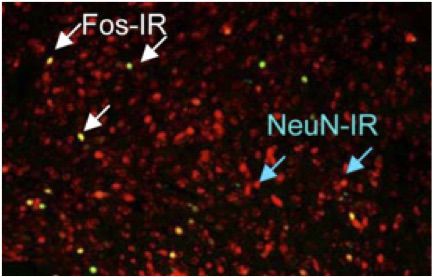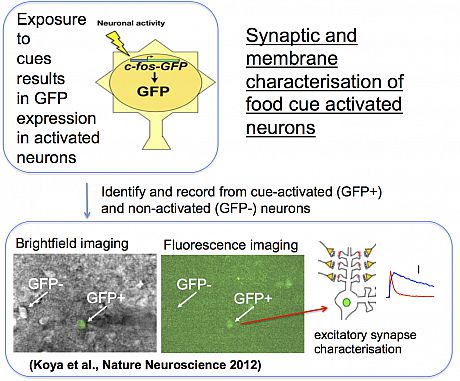Research Projects
Learned associations about food and drug rewards and the environment in which these substances are taken play an important role in the development of diseases such as maladaptive eating and drug addiction.

Such highly detailed information about different stimuli must be encoded by specific sets of neurons. During many learned behaviours a minority of sparsely distributed neurons with a constellation like appearance called ‘neuronal ensembles’ are activated. For many years neuroscientists wondered if these ensembles were involved in learned behaviours. However, their causal role for these behaviours could not be established, since tools to selectively manipulate these neurons without disrupting the surrounding neurons did not exist. Moreover, very little was known about the physiology of these neurons and whether they were part of a unique neuronal circuit, since tools to selectively characterise these neurons did not exist.
 Neuronal ensembles as observed using Fos immunohistochemistry. Fos (green) NeuN, neuronal marker (red) Note that only a minority of neurons express Fos.
Neuronal ensembles as observed using Fos immunohistochemistry. Fos (green) NeuN, neuronal marker (red) Note that only a minority of neurons express Fos.
In my previous research, my colleagues and I developed and optimized novel technologies to fill these critical gaps in knowledge about neuronal ensembles. We showed that learned associations about cocaine and its administration environment were mediated by neuronal ensembles in the nucleus accumbens, a brain reward area (Koya et al., 2009). It was also shown that these behaviourally activated, learning relevant neurons exhibited dynamic synaptic remodelling (Koya et al., 2012) compared to non-activated neurons. Finally, we showed that a minority of neurons activated during relapse to palatable food-seeking n the medial prefrontal cortex, a motivation-relevant area, exhibited unique excitatory inputs and synaptic strength compared to non-activated neurons (Cifani and Koya et al., 2012). Taken together, it was shown that neuronal ensembles mediated learned associations about drug effects and its administration environment, and were part of a unique neuronal circuit. Neuronal ensembles may also play a crucial role in food-mediated behaviours, since synaptic properties unique to food-seeking activated neurons were observed.
We are currently interested in answering these key research questions:
- Are learned associations about rewarding substances (e.g. food) and their associated environmental-stimuli mediated by neuronal ensembles in motivationally relevant areas such as the prefrontal cortex and nucleus accumbens?
- Do the neurons that mediate these learned associations exhibit unique intrinsic membrane properties and synaptic physiology? Thus, are these neurons part of a unique neuronal circuit?
In order to answer these questions we use a variety of approaches including c-Fos immunohistochemistry, selectively manipulation and characterisation of Fos-expressing neuronal ensembles (using e.g. FosTRAP2 and Fos-GFP mice (see below).
 Recording from activated GFP expressing neurons
Recording from activated GFP expressing neurons
Funded by:
BBSRC (BB/M009017/1): Changing strengths of learned associations: neuronal ensemble mechanism
BBSRC (BB/X000427/1): The masking, unmasking, and re-masking of food memories: neuronal ensemble mechanisms
![]()
MRC (Discovery Award): A window into the brain: imaging neural circuits involved in behaviour and neuropathologies
MRC (MR/T03260X/1): Resilience against food cravings via environmental enrichment (EE): neuronal ensemble mechanisms

• Sussex Strategic Development Funds
• Sussex Neuroscience 4-Year PhD Programme
• BBSRC SoCoBio PhD Programme


